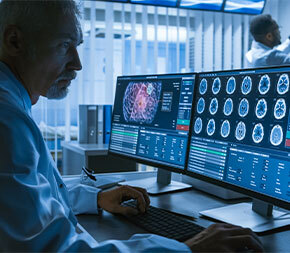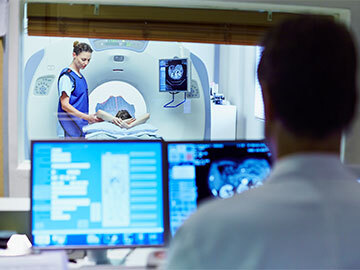
Medical imaging technology plays an important role in today’s health care system, and workers with the knowledge and skills to perform diagnostic imaging procedures are in high demand.
In short, medical imaging is the process of visualizing the body’s parts and organs in order for medical doctors and technicians to diagnose, monitor, and treat disease or injury. Medical imaging consists of several different types of imaging:
What Can You Do with Medical Imaging Training?
Medical imaging technicians are responsible for gathering images through X-rays, ultrasounds, and other equipment. These images are then used by doctors and other health care professionals to diagnose or more closely examine medical issues, concerns, or conditions. Medical imaging technicians play a huge role in giving physicians the up-close look needed to determine what type of care a patient needs.
There are many different types of medical imaging specializations, but two popular and lucrative options are radiology and sonography. Radiology relies on radiation waves to produce images, while sonography uses sound waves. Both of these imaging techniques require skilled technicians to operate the machines, and both are integral for patient care.
First, you’ll need to choose the field of imaging you want to pursue. You might consider the following career paths in the field:
Common outcomes for those who earn a medical imaging degree are to work in a medical setting as a technician, technologist, assistant, or nurse. All will have different educational requirements and levels of expertise. Assistants, for example, complete advanced studies and work directly under radiologists or medical specialists. Radiologic nurses are Registered Nurses who complete special training in treating patients who are undergoing medical imaging procedures, most commonly radiology. Radiologists are licensed medical doctors who are experts in interpreting digital imagery, and like all medical doctors must undergo four years of medical school, a year-long internship, and four years of residency in their medical imaging field.
Here’s What You’ll Do on Any Given Day
Your duties as a medical imaging technician will vary depending on the type of health care facility you work in. In general, you’ll be working with imaging equipment to capture a “picture” of an area of concern inside a patient’s body. You’ll also be making some preliminary assessments of the images before they’re handed off to a doctor. Specific duties will most likely include the following tasks.
Some variations exist among imaging technicians’ duties—radiologists use a radiation shield to protect patients whereas a sonographer doesn’t—but overall, the roles are similar in nature.
How to Get Started in Medical Imaging
Getting started depends upon where you currently are in your education or career. If you already work in the healthcare industry, entering the medical imaging field may be as straightforward as earning a certificate in a six-month program.
But if you’re sure this is the field for you and you’re just getting going, you’ll need to research schools and start learning which area of medical imaging you’d like to enter. You may be able to talk to technicians and technologists working in the field by asking questions at your local hospital and explain that you are trying to narrow your options. Finding out what you’ll actually do on the job and what a typical day is like is a great way to figure out what your focus should be.
No matter what area of medical imaging you choose, make sure your school is accredited and that you understand exactly what you’ll need to do to advance in the field after you earn your degree. Most employers prefer their medical imaging workers—no matter what area you pursue—to hold professional certification.
The History and Evolution of Medical Imaging
With Wilhelm Conrad Roentgen’s discovery of the X-ray in 1895, the field of medical imaging was born. The X-ray became the basis for other advancements in the field, such as mammography, tomography, angiography, and fluoroscopy, which developed subsequently in the 1920s, 30s, 40s, and 50s.
The 1950s were a peak time for advancement in medical imaging as nuclear medicine became a feasible diagnostic imaging tool. PET scans emerged from this technology and became the primary technique to diagnose cancer and its metastasizing to other parts of the body.
Ultrasound was first used clinically in the 1970s as did the first computed tomography scans, such as CT and MRI. Since there were previously no real ways to image the brain, ultrasound was a breakthrough in the field.
MR and MRI was a major step in imaging due to its ability to monitor treatments in real time and also its versatility. As technology speedily advances, most experts agree medical imaging is at an exciting crux, and doctors and technologists will be able to see if a therapeutic drug is working in a matter of hours, and disease will be detected less invasively—and more importantly, earlier and before it has progressed to the incurable stage.
Education and Careers in Medical Imaging
Choose an Accredited School or Program
An important component of your education will be making sure whatever program you choose is accredited, especially if you plan to become professionally certified after earning your degree. You can research which schools meet the standards agreed upon by the accrediting agencies and bodies by visiting their websites.
There are several accrediting bodies for medical imaging schools, and accreditation is key if you want to be sure your education is current, quality, and also enables you to apply for federal financial aid. Depending on which type of program you attend, here are some accrediting agencies to look for:
| Area of Specialty | Accrediting Body |
| Ultrasound Technology | Commission on Accreditation for Allied Health Education Programs (CAAHEP) in collaboration with the Joint Review Committee on Education in Diagnostic Medical Sonography (JRC-DMS) accredits most formal training programs. |
| Radiologic Technology | The Joint Review Committee on Education in Radiologic Technology accredits most formal training programs for the field. |
| Nuclear Medicine Technology | The Joint Review Committee on Education Programs in Nuclear Medicine Technology accredits most formal training programs in nuclear medicine technology. |
| Cardiovascular Technology | The Committee on Accreditation for Allied Health Education Programs in collaboration with the Joint Review Committee on Education in Cardiovascular Technology accredits most formal training programs. |
What You’ll Study
You’ll find a wide range of education programs; the certificate and diploma program are mostly for those already in the healthcare industry, such as nurses, but can get you started in the field and prep you to get your license.
A more common path, especially for radiology and sonography students is a two-year associate’s degree. These degree programs will qualify you to earn your license as well.
Bachelor’s degree programs include in-depth instruction and help you get a more rounded education in subjects such as math and English. If you want to enter a medical imaging field quickly, your best bet will be an associate’s degree, but if you aspire to move into technologist roles or actually become a radiologist, you should consider a bachelor’s degree program as you’ll need to build upon your four-year degree later.
No matter what education path you select, you’ll need to take some basic courses to understand the science and function of the human organism.
Basic Coursework for Medical Imaging
Radiologic tech programs may include:
Diagnostic medical sonography programs may include:
Medical Imaging Certification
Certification requirements vary from state to state, but medical imaging technicians are usually required to have some type of certification and possibly licensure in order to work.
If you choose to pursue a career as a sonographer, you can become certified by graduating from an accredited program and then passing a certification exam. Most certification exams will focus on a specialty, for example, abdominal sonography. Some states also require sonographers to become licensed. Certification agencies vary by state, so be sure to consult your state’s board of health for specific requirements.
For a career as a radiologic technician, most states require you to be licensed or certified. In order to be licensed in most states, radiologic technologists need to graduate from an accredited program and then pass a certification exam from their state or from The American Registry of Radiologic Technologist (ARRT). For specific state requirements, contact your state’s health board.
Salaries and Job Growth
Job growth and salary prospects are good for those who join the medical imaging field, largely because of an aging population with increasing healthcare needs. The U.S. Bureau of Labor Statistics anticipates a 5.5% job growth rate through 2032 for radiologic and MRI techs, while diagnostic medical sonographers will have a 14.3% growth for the same time period, and radiation therapy careers should grow at approximately 2.4%. The anticipated job growth rate for all careers nationally is currently 5%, so you can see medical imaging professions are ahead of the curve as far as growth.
Compare Medical Imaging Salaries
Finding Strength in Numbers
There’s no time like the present to start building a network and finding like-minded professionals to confer with. Here are some professional organizations dedicated to medical imaging careers to help you network and keep ahead of changes in your chosen field.
The Society of Diagnostic Medical Sonography
2745 Dallas Pkwy., Suite 350
Plano, TX 75093-8730
American Registry of Radiologic Technologists
1255 Northland Dr.
St. Paul, MN 55120
Society of Nuclear Medicine Technologists
1850 Samuel Morse Dr.
Reston, VA 20190
Cardiovascular Credentialing International
1500 Sunday Dr., Suite 102
Raleigh, NC 27607
American Society of Radiologic Technologists
15000 Central Ave. SE
Albuquerque, NM 87123-3909
Nuclear Medicine Technology Certification Board
3558 Habersham at Northlake, Building I
Tucker, GA 30084-4009
Medical Imaging Technician Personality Traits and Skills
Medical imaging technicians might capture images of broken bones, tissue abnormalities or even unborn babies in pregnant women. You can choose to work in one of two areas of medical imaging: Radiology (using radiation to obtain images) and sonography (using sound waves). Sound interesting? See if you’ve got the skills and personality for a job as a medical imaging technician.
You are…
You should have…
You may also enjoy:



